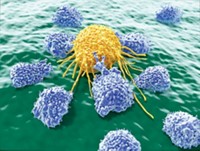Advertisement
Grab your lab coat. Let's get started
Welcome!
Welcome!
Create an account below to get 6 C&EN articles per month, receive newsletters and more - all free.
It seems this is your first time logging in online. Please enter the following information to continue.
As an ACS member you automatically get access to this site. All we need is few more details to create your reading experience.
Not you? Sign in with a different account.
Not you? Sign in with a different account.
ERROR 1
ERROR 1
ERROR 2
ERROR 2
ERROR 2
ERROR 2
ERROR 2
Password and Confirm password must match.
If you have an ACS member number, please enter it here so we can link this account to your membership. (optional)
ERROR 2
ACS values your privacy. By submitting your information, you are gaining access to C&EN and subscribing to our weekly newsletter. We use the information you provide to make your reading experience better, and we will never sell your data to third party members.
Cancer
An extra gene helps elephants resist cancer
The gene turns on in response to DNA damage, killing cells before they become cancerous
by Cici Zhang
August 14, 2018
| A version of this story appeared in
Volume 96, Issue 33

Cancer, in many cases, is a matter of chance. A cell randomly accumulates mutations to its DNA over time and some of those mutations can push the cell down the path toward cancer. As a result, large animals that have long life spans should have relatively high rates of cancer because their bodies’ many cells have ample time to eventually pick up a set of cancer-triggering mutations.
But that’s not true for elephants. These multi-metric-ton creatures live 60–70 years and rarely develop cancer. Scientists have been trying to uncover elephants’ secrets, which could inspire cancer treatments in humans.
Now, a team led by Vincent Lynch at University of Chicago shows that one way elephants evolved to resist cancer has been to pick up extra tumor suppressor genes (Cell Reports, 2018, DOI: 10.1016/j.celrep.2018.07.042).
Lynch and colleagues found one of these genes, called leukemia inhibitory factor 6 (LIF6), by comparing the genomes of elephants and closely related species. When the scientists damaged DNA in cultured elephant cells, a previously identified tumor suppressor gene called TP53 turned on LIF6, which then induced cell death through a protein that formed pores in the membranes of the cells’ mitochondria. The team concluded that elephants have a reduced cancer risk in part because this genetic circuit kills precancerous cells as soon as low levels of DNA damage are detected, instead of trying to repair the damage, which can risk accumulating more mutations.
When the researchers engineered mouse and hamster cells to express LIF6, the cells also self-destructed in response to DNA damage. Lynch says that after submitting the paper, his team performed a similar experiment in human cells and found the same effect.
Joshua Schiffman of the University of Utah who studies elephants and cancer, says “these new findings are intriguing and must now be validated by others.” If researchers can further elucidate LIF6’s mechanisms of action, that information could lead to potential cancer treatments, he says, but it would take many years.
Lynch is cautious about translating these findings into possible therapies. “I don’t think we’ll be using CRISPR to edit in copies of the LIF6 gene into humans any time,” he says. “But maybe we can design drugs that mimic the functions of LIF6 or some of the other genes.”
Carlo Maley of Arizona State University, who has studied elephants’ cancer resistance, points out that previous research showed TP53 interacts with a human gene related to LIF6 in placental implantation, so there might be a fertility tradeoff to targeting this pathway in cancer therapies. Although many questions remain about LIF6, Maley says, “it is interesting and exciting that we are discovering new biology of cancer prevention mechanisms.”




Join the conversation
Contact the reporter
Submit a Letter to the Editor for publication
Engage with us on Twitter